By the 15th century, the sgraffito technique had been adopted in northern Europe, influenced by the development of trade from Italy and south west France. The industry centred around Beauvais was extremely well established with a large export market.
Sgraffito ware was made in the Beauvais region of Northern France in large quantities in the 15th and 16th centuries. It has a fine white fabric, sometimes off-white, buff or grey. The forms include large and small bowls, large and small jugs, albarelli, chafing dishes and costrels. There are two types of decoration. Single sgraffito is a red slip scored to leave a yellow-white design. Double sgraffito is a red slip then a white slip. The white slip is scored to leave a red design. This imitates the Italian sgraffito (Hurst et al. 1986, 108).
The decorative motifs did not distinguish between single and double sgraffito methods. There is a wide range of designs including botanical subjects, geometric patterns, anthropomorphic designs, inscribed mottoes and proverbs, and the flanges of large bowls often have crudely executed stylised leaf patterns (ibid, 110).
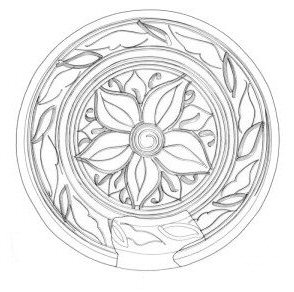
Figure 20: Beauvais single sgraffito rosette bowl (after Hurst et al. 1986, 111)
All types of Beauvais sgraffito ware are found throughout Britain and the Low Countries, the bowls being most common. Deposits in Chester dated to the 16th century produced fragments of a Beauvais plate and jug (Davey and Rutter 1977, 22). Excavations in Castletown, Isle of Man, recovered plates in double and single sgraffito dated to the 16th century (Davey et al. 1996, 73). Five vessels have been found in Norwich, four plates and a jug (Jennings 1981, 96). The date given to finds in Southampton is late 15th century to early 16th century (Allan 1983, 199). A survey of Beauvais sgraffito finds in Wales shows that they are present, in particular along the south coast, with one site in the north (Evans 1983, 14).
In the 18th century sgraffito decoration was again popular, and there are examples from Sevres and Beauvais. This ware was not traded, as local producers in Britain and elsewhere had developed their own markets (Hurst et al. 1986, 114).
A kiln site at Utrecht in the Low Countries began producing slipware from about 1400 onwards. Dishes were the most common form. There are a few examples of the sgraffito decorative technique on some dishes found at the kiln site dated 1400-1425. One design is of a bird with sgraffito details and stabbing on the bird itself. Another motif is of a stag with sgraffito lines and dots used to highlight the face and body of the animal (ibid, 146).
The Utrecht-type slipware was superseded by true sgraffito. The first dated piece is 1503. This method of decoration was used in the Low Countries until about 1550, when slipwares became predominant. Sgraffito ware is found throughout the Low Countries into the mid-16th century and it also occurs on sites in east and south Britain (ibid, 150).
It has a hard red-brown sandy fabric with a white slip which is incised to show the red body beneath. It is covered in a lead glaze. Large dishes are the main type. Decoration includes heraldic motifs which are sometimes surrounded by bands of gillette, religious subjects and inscriptions.
From about 1550 slipware became the predominant method of decoration for wares produced in the Low Countries. North Holland Slipware was particularly important and has been found on sites throughout north-west Europe and Britain. It was common throughout the 17th century and early in the 18th century. At the beginning of the 17th century some of the designs had sgraffito detail (ibid, 154).
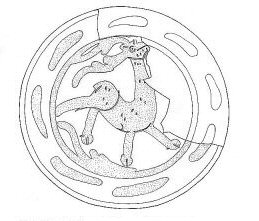
Figure 21: Utrecht slipware stag dish (after Hurst et al. 1986, 147)
In the late 16th century and early in the 17th century, an extensive slipware industry grew up along the Werra river in northern Germany. The wares were exported through the port of Bremen in large quantities to the Low Countries, England, Scandinavia and British North America. It has been given the name Werra Slipware (previously called Wanfried after the site where it was first found). The pieces are often dated; 1568 is the earliest and 1653 is the latest. Most dated items are between 1590 and 1625. The main period of export to the Low Countries was 1580-1630 (ibid, 242).
The wares have a red-brown sandy fabric, and the main forms are dishes and bowls. Other forms include pipkins, tankards and jugs. Decoration is a pale greenish-yellow slip with a variety of designs in the centre outlined in sgraffito. The central motifs include anthropomorphic, zoomorphic, botanical and geometric. There are often dashes decorating the rim edge, with one or two bands of thin spiral lines below this around the central motif. There appears to be no chronological sequence of patterns nor differences in design between the kilns (ibid, 242-4).
Werra ware is found on many sites in England, predominantly on the east coast. Finds of flatwares in Norwich date from 1588-1625. At least 70 vessels have been found (Jennings 1981, 78). Fragments of two plates have been found in Chester (Davey and Rutter 1977, 26). A single vessel found at Haughton Green, Denton, near Manchester, has a date of 1619 inscribed on it (Davey 1994, 50). It is thought that this piece was brought to England by the Huguenot family who worked the glasshouse at Haughton Green (Vose 1994, 1).
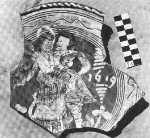
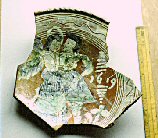
Figure 22 (a-b): Werra slipware, sgraffito dish dated 1619. © Ruth Hurst Vose
Another ware, visually identical to Werra in fabric and decoration, was produced in North Holland at the port of Enkhuizen. The kilns were probably only in operation from 1602-1610 (Hurst et al. 1986, 248). It is called Enkhuizen-Werra type ware. A number of wasters from this site have the initials DCS, identified as Dirck Claesz Spiegel, the owner of the kiln. Werra ware is usually dated but does not include names or initials. At the time of writing, Hurst noted that it was rare on other sites in the Low Countries and none had been identified in Britain. A full study is awaited for more details on this ware (ibid, 248).
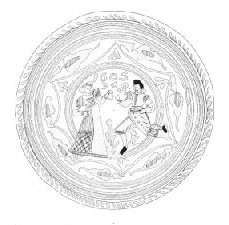
Figure 23: Enkhuizen-Werra type slipware: sgraffito dish dated 1605 (after Hurst et al. 1986, 249)
© Internet Archaeology
URL: http://intarch.ac.uk/journal/issue16/1/ch7.2.html
Last updated: Wed Mar 24 2004